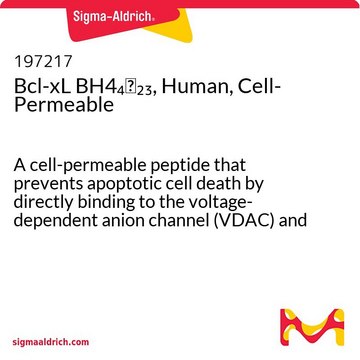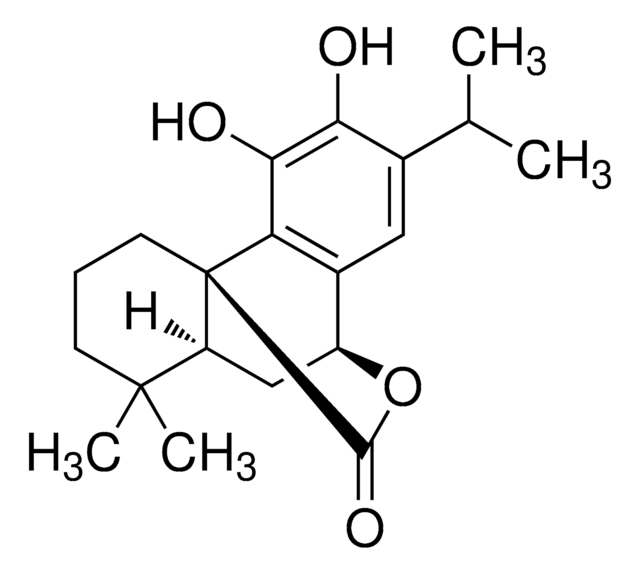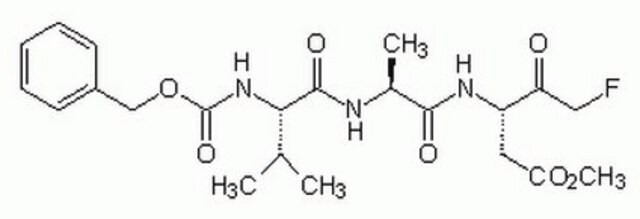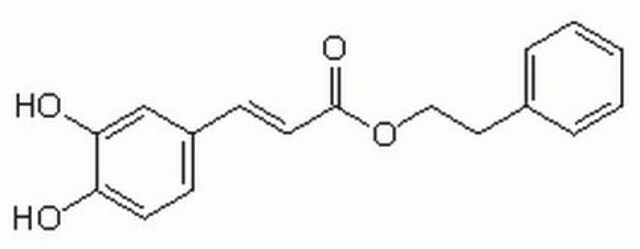376816
Peptyd domeny wiążącej heksokinazę II VDAC, przepuszczalny dla komórek
A cell-permeable peptide analog of Hexokinase II VDAC binding domain peptide.
Synonim(y):
HXK2VBD-cpm, H- RQIKIWFQNRRMKWKK-MIASHLAYFFTELN-NH₂
Zaloguj sięWyświetlanie cen organizacyjnych i kontraktowych
About This Item
Wzór empiryczny (zapis Hilla):
C188H291N53O40S2
Masa cząsteczkowa:
3997.78
Kod UNSPSC:
12352202
NACRES:
NA.77
Polecane produkty
Poziom jakości
Próba
≥95% (HPLC)
Formularz
lyophilized solid
producent / nazwa handlowa
Calbiochem®
warunki przechowywania
OK to freeze
desiccated (hygroscopic)
protect from light
kolor
white
rozpuszczalność
water: 1 mg/mL
Warunki transportu
wet ice
temp. przechowywania
−20°C
Opis ogólny
Przepuszczalny dla komórek peptydowy analog peptydu domeny wiążącej VDAC heksokinazy II (nr kat. 376815). Domena internalizacji homeoproteiny Antennapedia jest połączona z metioninowym końcem aminowym. Wykazano, że całkowicie odłącza i przenosi HXK2 z mitochondriów do cytozolu w komórkach HeLa w stężeniu 100 µM. Nie indukuje translokacji Bax ani uwalniania cytochromu c, gdy jest stosowany samodzielnie. Jednakże wyraźnie uwrażliwia komórki na uwalnianie cytochromu c i indukcję apoptozy, gdy jest stosowany w połączeniu z induktorem apoptozy zależnym od Bax, indometacyną (nr kat. 405268).
Działania biochem./fizjol.
Główny cel
Odłącza i przenosi HXK2 z mitochondriów do cytozolu.
Odłącza i przenosi HXK2 z mitochondriów do cytozolu.
Odwracalny: nie
Produkt nie konkuruje z ATP.
Przepuszczalność komórek: tak
Opakowanie
Pakowane w atmosferze gazu obojętnego
Ostrzeżenie
Toksyczność: Standardowa obsługa (A)
Sekwencja
H-Arg-Gln-Ile-Lys-Ile-Trp-Phe-Gln-Asn-Arg-Arg-Met-Lys-Trp-Lys-Lys-Met-Ile-Ala-Ser-His-Leu-Leu-Ala-Tyr-Phe-Phe-Thr-Glu-Leu-Asn-NH₂
Inne uwagi
Pastorino, J.G., et al. 2002. J. Biol. Chem.277, 7610.
Holinger, E.P., et al. 1999. J. Biol. Chem.274, 13298.
Sui, D., and Wilson, J.E. 1997. Arch. Biochem. Biophys.345, 111.
Holinger, E.P., et al. 1999. J. Biol. Chem.274, 13298.
Sui, D., and Wilson, J.E. 1997. Arch. Biochem. Biophys.345, 111.
Informacje prawne
CALBIOCHEM is a registered trademark of Merck KGaA, Darmstadt, Germany
Ta strona może zawierać tekst przetłumaczony maszynowo.
Kod klasy składowania
11 - Combustible Solids
Klasa zagrożenia wodnego (WGK)
WGK 1
Temperatura zapłonu (°F)
Not applicable
Temperatura zapłonu (°C)
Not applicable
Certyfikaty analizy (CoA)
Poszukaj Certyfikaty analizy (CoA), wpisując numer partii/serii produktów. Numery serii i partii można znaleźć na etykiecie produktu po słowach „seria” lub „partia”.
Masz już ten produkt?
Dokumenty związane z niedawno zakupionymi produktami zostały zamieszczone w Bibliotece dokumentów.
Jia Sun et al.
Redox biology, 39, 101811-101811 (2020-12-29)
Vascular complications of diabetes are a serious challenge in clinical practice, and effective treatments are an unmet clinical need. Acidic fibroblast growth factor (aFGF) has potent anti-oxidative properties and therefore has become a research focus for the treatment of diabetic
Nasz zespół naukowców ma doświadczenie we wszystkich obszarach badań, w tym w naukach przyrodniczych, materiałoznawstwie, syntezie chemicznej, chromatografii, analityce i wielu innych dziedzinach.
Skontaktuj się z zespołem ds. pomocy technicznej








